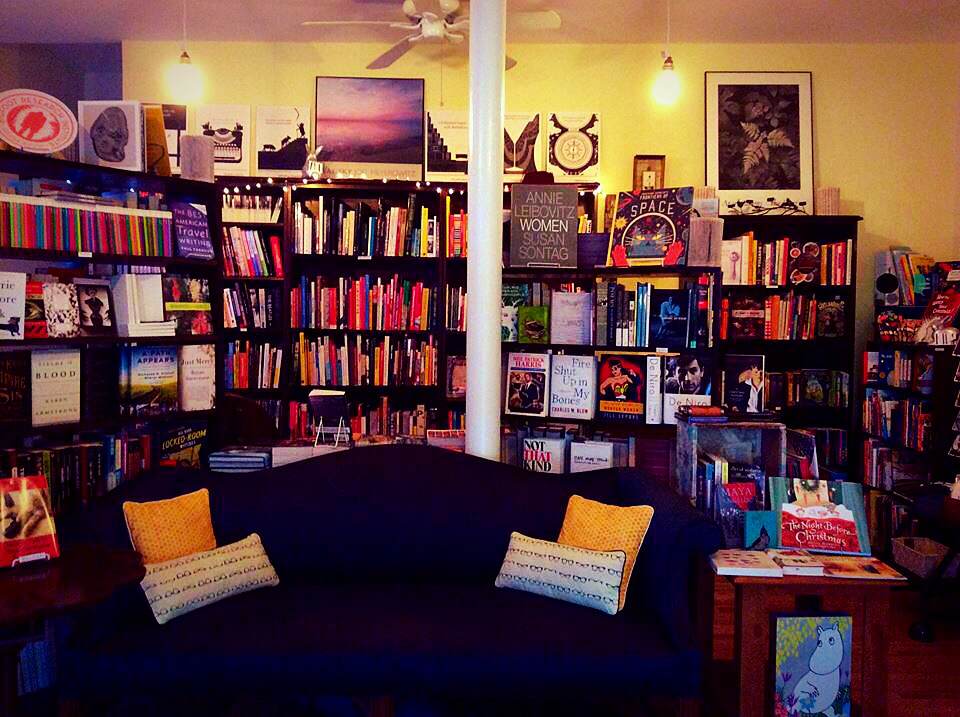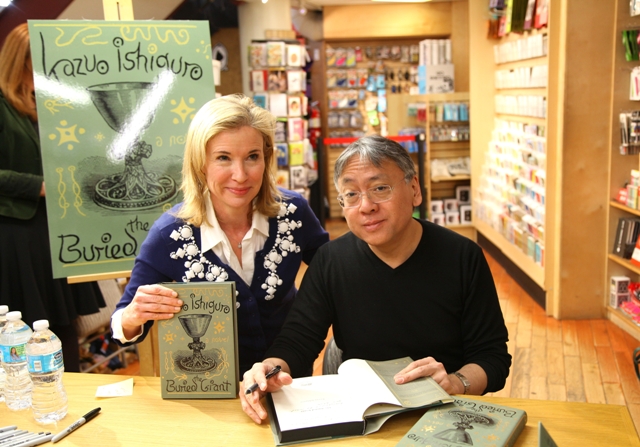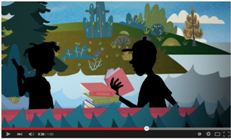David Goldberg, whose day job is sales and marketing director at David R. Godine, Publisher, reports on Boston's newest bookstore.
Papercuts J.P., opened on Small Business Saturday 2014 to great fanfare (and more than 2,000 likes on Facebook). In just over three months, the 500-square-foot shop has discovered its community and--in spite of record snow--piled up impressive sales while hosting authorless events, music and community conversations, as well as "untimely" readings by local authors William Martin and Celeste Ng.
 Located just off bustling Centre Street in Boston's Jamaica Plain neighborhood, Papercuts has filled a void, connecting books and readers--many of whom, like the "super-supportive" duo of Gareth and Amanda Cook, work in publishing or are writers themselves.
Located just off bustling Centre Street in Boston's Jamaica Plain neighborhood, Papercuts has filled a void, connecting books and readers--many of whom, like the "super-supportive" duo of Gareth and Amanda Cook, work in publishing or are writers themselves.
"People have been enthusiastic that we're here," owner Kate Layte said. "It's blown my expectations completely."
Although she's quick to give credit to the New England Independent Booksellers Association, other shops and wholesalers, Layte noted "Local publishers have been amazing, even hand-delivering books," including Layte's top seller, Dirty Old Boston: Four Decades of a City in Transition by Jim Botticelli (Union Park Press).
In addition to more predicable favorites like Girl in a Band by Kim Gordon (Dey Street Books), Bad Feminist: Essays by Roxane Gay (Harper Perennial) and Citizen: An American Lyric by Claudia Rankine (Graywolf), Layte highlights brisk sellers from Philip Pullman's and Megan Abbot's backlists along with a series of 12-page zines discovered by Layte's husband--How to Talk to Your Cat About Evolution and How to Talk to Your Cat About Gun Safety.
Good design matters to Layte, who previously worked in production at Little, Brown. The sole book currently displayed at the register is What We See When We Read by Peter Mendelsund (Vintage), which Layte offers less as an impulse buy than as an opportunity to talk aesthetics with her customers. "I love to point out [that he's the associate art director at Knopf] when someone buys a book he designed."
Like neighboring businesses, Layte locally sources as much as possible, filling the walls and shelves with hyper-local sidelines from artists she's discovered during neighborhood open studios.
The most important lesson from Layte's first 100 days seems to be that change is good--and that more is sometimes, but not always, better. Expanding her children's section, she's keen to present titles that aren't generally sold at neighborhood toy stores, opting for books that are more "under the radar." She commented: "To display books well is really important, and I've had to figure out how to do that here, using every inch of space and rethinking things as I go."
Running an intimate boutique like this is almost like offering up one's own personal bookself, and the warm welcome and early success is obviously gratifying. When asked how she handles receiving without any storage or back office, Layte doesn't hesitate to say, "Quickly."
 AK Press, the anarchist publishing and distribution collective in Oakland, Calif., suffered extensive water and smoke damage on early Saturday morning after a fire in an adjacent building. On its website, AK Press wrote, in part, "We still aren't sure the exact amount of stock that is ruined, or how long our business will be disrupted while we work hard to get back on our feet. But we do know that we've lost a lot, and even in the best of times, we always need your support. Especially now when we aren't able to carry on with our normal day-to-day business, every bit helps."
AK Press, the anarchist publishing and distribution collective in Oakland, Calif., suffered extensive water and smoke damage on early Saturday morning after a fire in an adjacent building. On its website, AK Press wrote, in part, "We still aren't sure the exact amount of stock that is ruined, or how long our business will be disrupted while we work hard to get back on our feet. But we do know that we've lost a lot, and even in the best of times, we always need your support. Especially now when we aren't able to carry on with our normal day-to-day business, every bit helps."








BINC.0325.T2.SUSANKAMILEMERGINGWRITERSPRIZE.jpg)

 The annual
The annual  Located just off bustling Centre Street in Boston's Jamaica Plain neighborhood, Papercuts has filled a void, connecting books and readers--many of whom, like the "super-supportive" duo of Gareth and Amanda Cook, work in publishing or are writers themselves.
Located just off bustling Centre Street in Boston's Jamaica Plain neighborhood, Papercuts has filled a void, connecting books and readers--many of whom, like the "super-supportive" duo of Gareth and Amanda Cook, work in publishing or are writers themselves. Kazuo Ishiguro visited the
Kazuo Ishiguro visited the 
 The Island of Dr. Libris
The Island of Dr. Libris Alejandro Jodorowsky, the Chilean filmmaker who in 1970 wrote, directed and starred in the groundbreaking El Topo, is also a superb novelist. Where the Bird Sings Best follows three generations from both sides of the author's Jewish family--beekeepers on one side, lion tamers on the other--in one gloriously readable, fantastical autobiographical novel.
Alejandro Jodorowsky, the Chilean filmmaker who in 1970 wrote, directed and starred in the groundbreaking El Topo, is also a superb novelist. Where the Bird Sings Best follows three generations from both sides of the author's Jewish family--beekeepers on one side, lion tamers on the other--in one gloriously readable, fantastical autobiographical novel.